Want to jump straight to the answer? The best onboarding software tool for most people is either GoCo or Lessonly by Seismic.
Bringing a new hire on successfully is a win-win. If they land well, there’s a much higher chance they’ll stay and perform.
Onboarding software creates a smooth, professional transition every time. It helps you build clear checklists and workflows to guide new hires through those all-important early days.
We identified the best onboarding software on the market and talked with active users about their experience. How well did these products really work over months and years?
The 5 Best Onboarding Software
- GoCo – Best for organizations growing past 100 employees
- Lessonly by Seismic – Best for training 25+ new hires per month
- Trainual – Best for upskilling employees quickly
- Gusto – Best for combining simple onboarding and payroll
- BambooHR – Best single platform for recruiting and onboarding
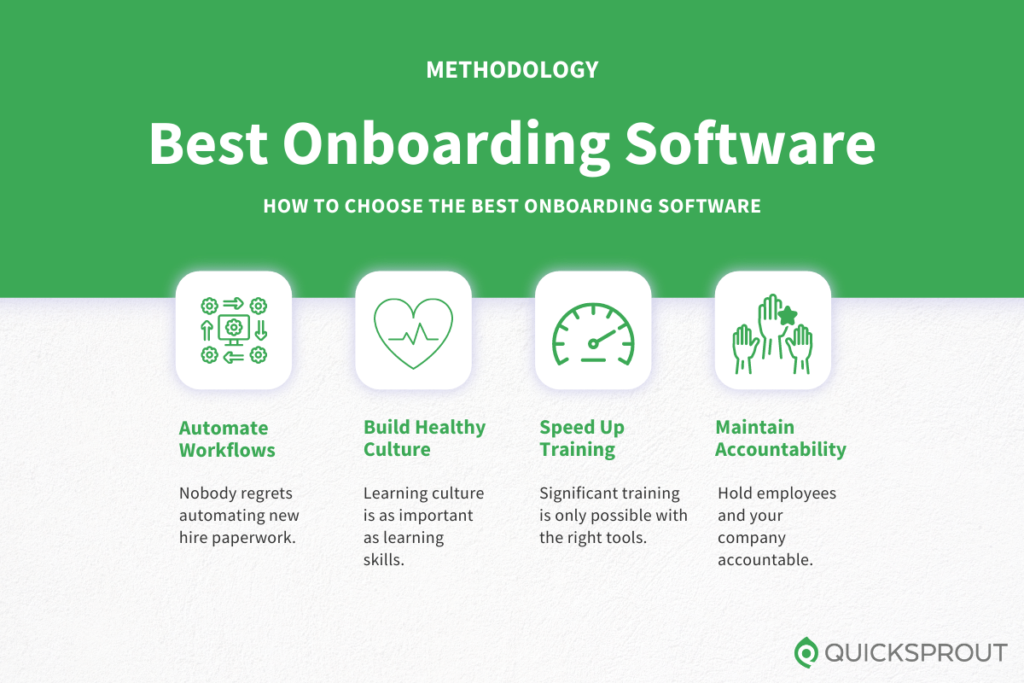
Onboarding means different things depending on where you work. For some, it’s just getting people set up on payroll and plugged into your HR system. For others, onboarding is a process that takes weeks or months and involves significant training.
In conversations with active users of all the onboarding software that I’m recommending, we figured out which works best for each situation. Below, you’ll find in-depth reviews of every top product, followed by a brief buyers guide to help you navigate your options.
GoCo – Best for Organizations Growing Past 100 Employees
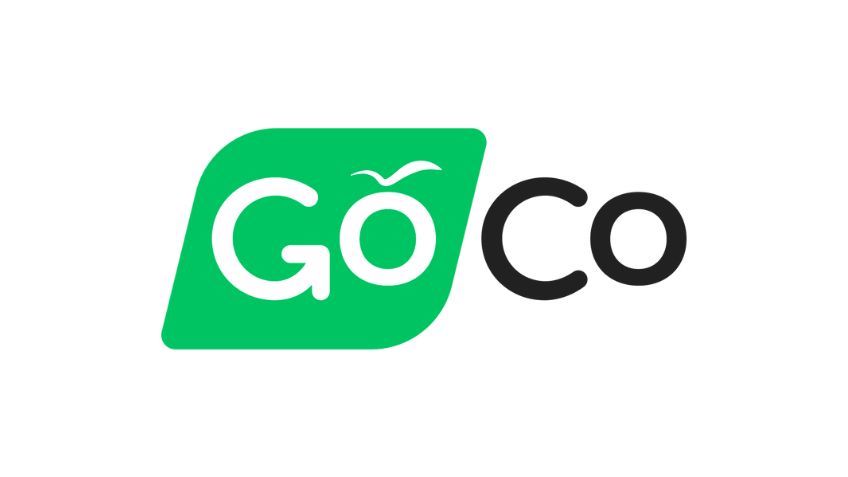
GoCo lets companies build out the perfect onboarding experience. It’s a blank slate that lets you design something that really fits your organization–say goodbye to cookie-cutter templates and workflows.
The results are stunning, with users describing a nearly hands-free onboarding process once it was programmed. You want to have something like this in place before you hit that fast-growth stage, but once you do, you can scale up your hiring as quickly as you like.
You can build out exactly what you need with GoCo, put it on autopilot, and iterate to perfection with great visibility into your hiring data.
Where GoCo Excels
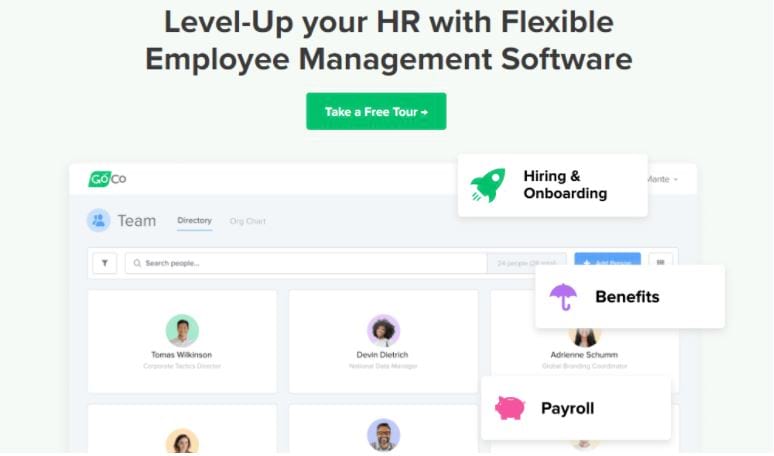
GoCo really puts companies in the driver’s seat in terms of defining their onboarding process with:
- Customizable onboarding workflows: You’ll have complete control over how you want to set up your onboarding process. You can add steps for additional training, compliance, and different roles.
- Powerful document creator: GoCo’s Magic Documents really lived up to the hype in terms of how easy and useful they were. You can add eSignatures and customizable fields to any document of yours. Users were able to create, sign, and track any document they used.
- Exceptional customer service: Users spoke highly of agents, account reps, and even said their feature requests actually turned into new features. Given that GoCo takes some legwork to get set up, this reliable support is especially valuable in the early days.
At its core, GoCo is an HR administration system. But with its customizable workflows and best-in-class document creator Magic Docs, it’s going to offer a lot more in the way of structured training to your employees than either of the other HR-focused options, such as Gusto and BambooHR.
You’ll be building your workflow from the ground up. You’re not trying to squeeze your process into an off-the-shelf workflow that may or may not mirror how things work on the ground.
Plus you get to choose which HR services you buy from GoCo. There are no packages to try and fit into or features you can only get by upgrading. Gusto and BambooHR only offer pre-set packages.
And the workflow builder is both really advanced in function and surprisingly simple in design. You’ll have a granular ability to get into the process and create every efficiency you can.
You’re not stuck with the standard onboarding workflows–any policy or process you have can work within GoCo. You can standardize how things are done using the simple interface:
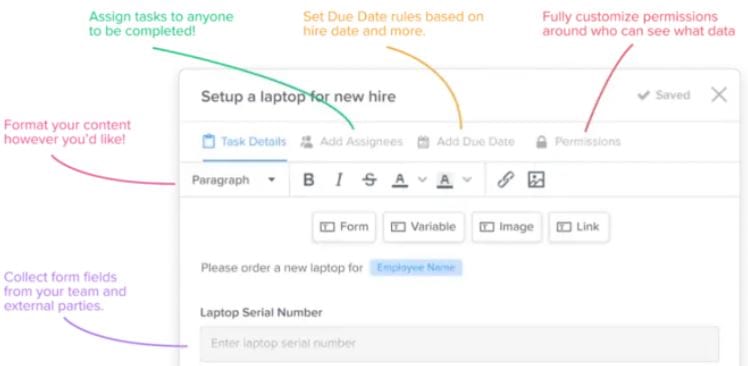
You have a lot of freedom to customize fields, permissions, and where you pull data from. It’s going to take some time to get right, but when people talk about “programming” a GoCo workflow, they don’t mean software development. This is all drag, drop, point, and click–you’re not going to have to code anything.
An HR manager in a city government with 275 employees talked with us about how much time she saved using this builder.
“Once you program the workflow, it does it all itself,” she said, offering an example of a manager having to approve a payroll adjustment for a new hire. “The manager automatically gets the email reminder, and there’s a link in the email that takes them straight to where they need to go.”
People forget things. It happens. But with GoCo at the helm, new hires aren’t left in the lurch waiting for an approval they can’t see. And HR staff isn’t chasing people down, either. “[GoCo] removes that workload off of us having to keep track, follow up, babysit, and handhold,” the same city HR manager said.
Users also complimented GoCo’s customer support teams extensively. “Our account representative is amazing,” said one user. She would email after work hours and get a response in 15 minutes. “I told her to stop working so late, she tells me the same.”
Another user said GoCo support reps would “go in themselves and create those workflows and then just have us edit them.” This level of support was really helpful, especially with software like GoCo, which requires a little more setup legwork than some other platforms on this list.
The end result is a clear view for admins, tracking every step of the process and where each person is.
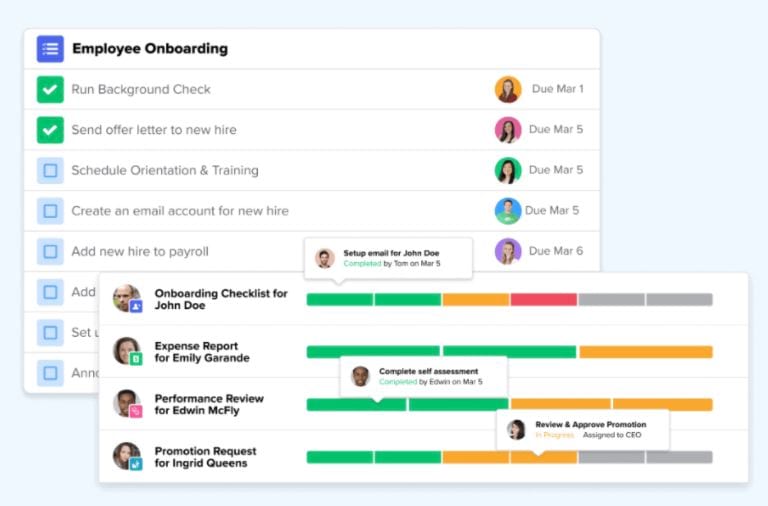
Users really raved about the Magic Docs program, which lets you create customizable fields in any document. You can upload all your HR docs to GoCo and start making them more intelligent. It doesn’t matter if they are PDFs, simply start adding text fields, dropdowns, signature fields, checkboxes, and more.
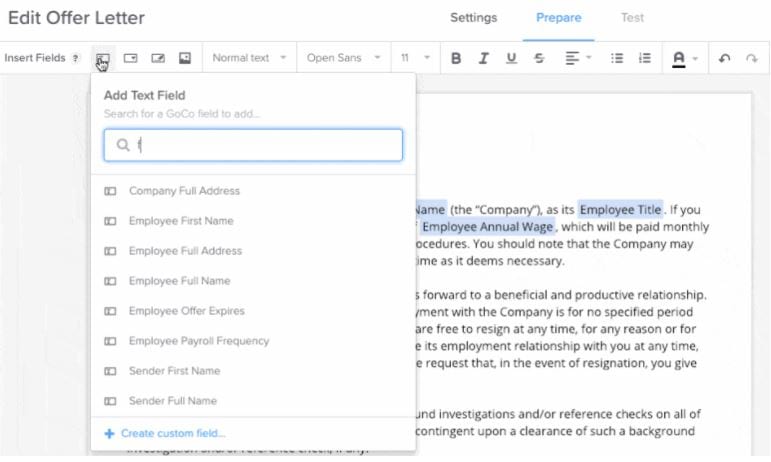
“Employee handbook, direct deposit, offer letter. Like I said, any letter that we wanted,” one user said, “I was able to create templates and embed the signature blocks in them.” With Magic Docs, they were able to keep using their own documentation, it just worked better.
“A lot of them auto-populate with employee information,” she continued, “and then once that workflow was created, it just does everything on its own.”
Trying to manage all your eSignatures and docs using a third-party app like DocuSign gets really hard once you start to hire quickly. Keeping everything in one place with GoCo is going to be a lot less hassle for administrators.
As we mentioned, this freedom to create workflows with your own documentation lends itself to a lot more training potential than you see with your typical HR software, like Gusto or BambooHR.
One user told us about how they were able to see real results by adding basic training to their onboarding using GoCo workflows. “I will say that the training videos for drivers right at the beginning of their onboarding have led to a 30% decrease in minor accidents. Rear ends, traffic stops, traffic violations, things like that.”
There are no built-in video features to GoCo, but this user simply embedded a private YouTube link to a short video they created. “Our company has 65 vehicles that are driving every single day,” he said. “So 30% [accident] reduction in 65 vehicles going around, that’s a lot of deductibles.”
You can see how GoCo’s excellent ability to pull reports is extremely valuable here. Admins will be able to see who has taken which courses, and in the event that insurance wants to audit your training, you’ll be completely set up.
Finally, this is a company that wants to help its customers and is constantly adding new features.
Where GoCo Can Improve
GoCo is a relative newcomer to the space, and there are a few places users wanted to see improvement:
- Mobile app is laggy: the GoCo app has a long way to go to catch up with the sleek and dependable desktop version.
- Few course creation tools: while users did train people with GoCo, additional tools for building courses and monitoring progress would be nice
- No social feed: some users missed the ability to share milestones and important announcements on the employee portal, which isn’t available in GoCo.
We were a little surprised to hear about the poor performance of the GoCo mobile app, given how modern the rest of their platform felt to users. One iPhone user complained about the slow load time, disappearing buttons, and difficulty navigating. “It’s really desktop software,” he said, “They have told me they’re coming out with a new app, but I haven’t seen it yet.”
The employee portal is also not quite as well developed as some of the other HR-based onboarding software we recommend. It’s fine, but Gusto’s is a little sleeker and BambooHR’s is a little more robust.
In BambooHR, for example, there’s a social feed. GoCo doesn’t have that. It’s “something that I’m used to, but not something that we necessarily have to have,” one HR manager said, “We can’t put [out] notices, reminders, links, those types of things.”
Other users had some concerns about employee access in the portal. In GoCo, users have the freedom to edit things like their name and social security number, which can totally mess up payroll even if done by accident.
As one user said, “We have to make it a point to explain to the employees: When you log on, don’t change your name, don’t change your social, don’t change anything other than your address and your email address.”
Given how customizable GoCo is, it’s certainly possible to use it to train employees. Compared to Lessonly or Trainual, however, the course creation is not going to be as easy, and it would take a ton of work to make it as engaging.
For basic training, especially where you can incorporate your own content, GoCo is going to work well. But if you need to create your own content, or you want to create substantial courses for new hires, GoCo doesn’t offer the same level of function.
The other thing to be aware of is that the workflows take time to build, test, and perfect. This is fairly common sense, but it’s something for buyers to be aware of when there are other much more turnkey options out there.
Gusto, for example, can’t handle the complexity that GoCo can and won’t scale as neatly, but it’s pretty much ready to go when you turn it on. GoCo, by contrast, is a blank slate–it’s going to take more time to get set up, but there is so much more you can do to scale.
“I really wouldn’t recommend [GoCo] for a very small business,” said one HR director. “It doesn’t make much sense for one location with five, 10, 15 employees, but it does make sense for either rapid growth companies like we were or larger companies that need to track a lot of data across a lot of locations.”
We agree with this assessment. BambooHR and Gusto are much better products for small businesses with simple onboarding needs–GoCo will likely overwhelm you if you only need the basics.
GoCo Pricing

GoCo pricing starts at $5 per user, but you’ll have to get in touch with GoCo for a custom quote.
The lack of public pricing is somewhat frustrating, but the tradeoff is that you can pick and choose the exact set of features you need. Contrast this with BambooHR and Gusto, which offer bundles that may or may not fit your needs.
The base package that comes as part of every GoCo plan includes:
- Hiring
- Onboarding
- Employee self-service
- MagicDocs
This is the essential toolkit you’ll need to manage onboarding. Notably, however, GoCo’s hiring package does not include applicant tracking software, which BambooHR’s does. You can integrate a variety of ATS with GoCo, but it’s not included as part of the platform.
On top of the base package, you can add the HR services you need, such as:
- Benefits
- HR workflows
- Payroll
- Paid time off
- Time tracking
You also have the option of purchasing on-demand HR support and white-glove implementation. If you don’t have a ton of HR or IT know-how in-house, it may be cost-effective to use these options to have GoCo’s help getting set up, or support on speed dial.
Users we spoke with were very happy about the price of GoCo, especially with what it delivered. One user we spoke with worked for a city hall, and “being a governmental entity, obviously, we are very limited on budget and we have to be fiscally responsible.” They tested a lot of options, but nothing within their budget was nearly as capable or user-friendly as GoCo.
Bottom line: GoCo is the best solution for companies willing to invest in a comprehensive onboarding process that automatically helps them scale up their hiring.
Lessonly by Seismic – Best for Training 25+ New Hires Per Month
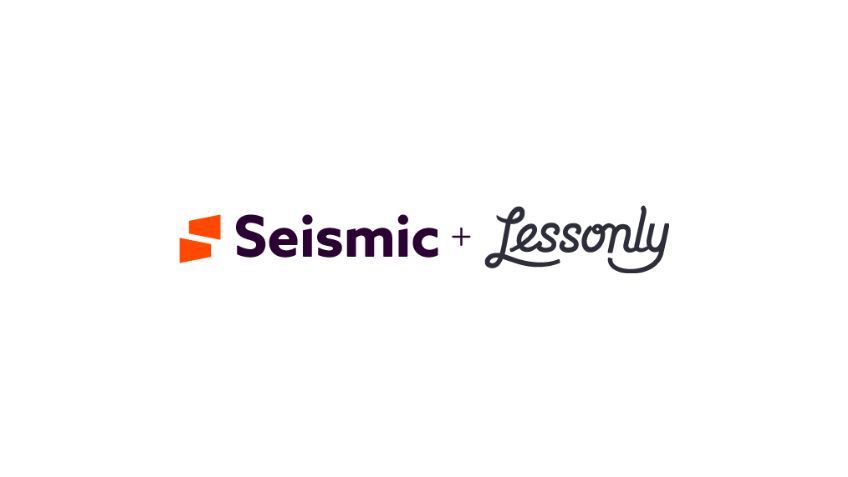
Lessonly by Seismic is a full-service learning management system that companies use for large-scale onboarding and employee training.
It’s best for companies that are consistently training dozens of new hires. We’d highly recommend it for sales, customer service, as well as any regulated industries where new hires have to understand key legal or workplace safety concepts before jumping in.
Instead of pulling your experienced folks away from their work to oversee this training, you can use Lessonly by Seismic to help new hires help themselves. Setting everything up for dozens of roles will take time, but the investment was clearly worth it to the users we spoke to.
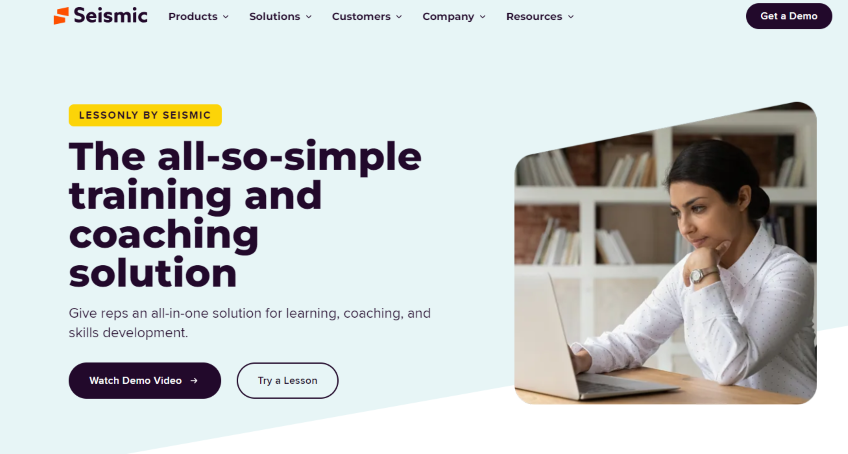
Where Lessonly by Seismic Excels
Lessonly by Seismic is a favorite for mergers and acquisitions where a substantial amount of concurrent training is necessary. It’s not just for entry-level hires, as you can build out learning paths for employees at any stage, as well as for contractors and customers that need to use your service.
This functionality can work well for any large company where onboarding is tied to learning requirements.
Specifically, Lessonly by Seismic is excellent at:
- Deep course-building tools: Lots of pre-built templates for lessons, quizzes, tests. Lessonly by Seismic gives you tons of ways to break down the key information and ensure that people are actually learning.
- Employee accountability: Lessonly by Seismic gives admins a real-time view of employee progress through different learning paths tied to specific roles. Tie courses to compliance with a clear record of who has done what. If you are ever audited, clear records are a click away.
- Clear paths for employee development: New hires know exactly what they need to do to move up. Users told us this clears up confusion, motivates employees to strive, and increases retention significantly.
Normally when you’re talking about software that can handle onboarding for an enterprise merger, it’s pretty cumbersome. That is not at all the case with Lessonly by Seismic according to the users we spoke with, who found the process of designing courses very easy.
One director of HR at an exterior cleaning company was able to build most of what she needed off a course single Lessonly by Seismic template she liked. “I just copied it a thousand times and built every lesson into that,” she said, “And that’s been a win for me because back in the day when I was building all the lessons, I didn’t have time to put into administrative duties for it.”
Basically, there is a ton that you can do with Lessonly by Seismic, but none of the backend setup is rocket science.
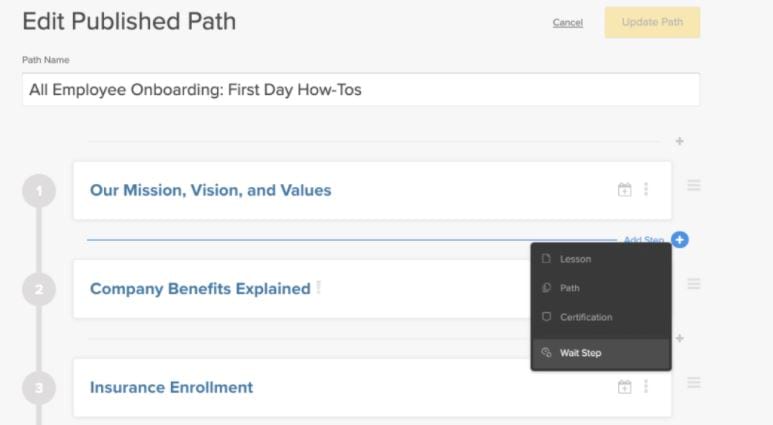
Another HR director working for an insurance company told us about how the pre-built Lessonly by Seismic content saved her from building lessons altogether. “If you don’t have it available for your own company, you can use what they have.”
The same is true, she said, of stock images, icons, and other useful resources that Lessonly by Seismic includes. ”So really even if as a business you are new and you don’t have a brand identity or anything,” she said, “they have everything that you might need to make your page look quite professional.”
At the insurance company, the HR director used Lessonly by Seismic internally to train and upskill employees, as well as externally to train brokers on how to sell their products. Because her company is involved with insurance, there’s a lot of legal stuff for everyone to know.
She said Lessonly by Seismic really helped them make their course content interactive and engaging. She acknowledged that for new hires, reading up on insurance could be “really boring,” but with Lessonly by Seismic, “it’s still professional, but they’ve really put a fun spin to it, to make it less, ‘This is a compulsory lesson you need to take.’”
For the exterior cleaning company, training new employees is a matter of life or death. For her, engaging lessons were important, but she really had to be sure that employees were learning the material. “Like if you mix this chemical with that other chemical, you will poison yourself,” she said. “We want people to know that before they’re out on a job site.”
Not everyone is working with super dangerous chemicals, but making sure you can assign jobs based on which employees have sufficient training is valuable for lots of companies. Lessonly by Seismic makes it easy to coordinate all of this.
“I can run a report to see if they have done the lesson, how long they spend in it, what score they got,” the same user explained. It’s all available in her admin dashboard, “so I don’t have anything set up where I’m requesting something back from an employee through Lessonly by Seismic.”
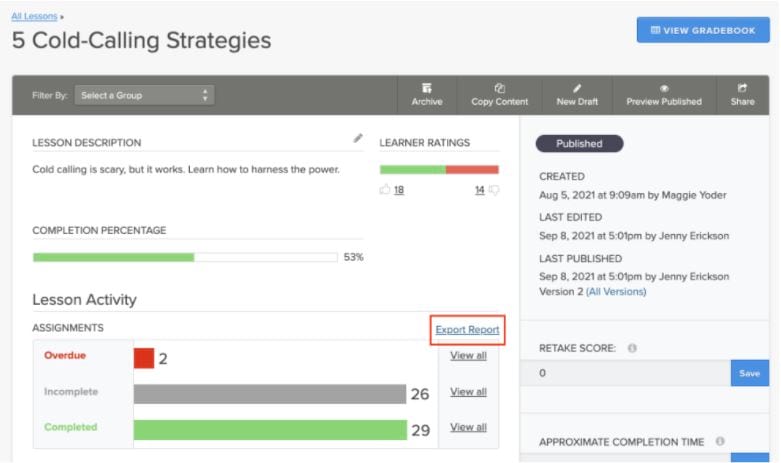
This kind of oversight is critical for companies in regulated industries and those who need new hires to have a lot of “local knowledge” immediately. You can cut down on the time it takes to ramp up rookies and get them contributing faster.
And if you are ever audited, it only takes a minute to pull all the information you need about who has taken the required courses, made the appropriate acknowledgments, and so on.
But there’s a deeper payoff that comes with providing people a clear path forward on day one. They know what they have to do to receive a promotion, raise, or get put on the big-ticket jobs. We heard from Lessonly by Seismic users that this really led to a better sense of team culture, increased transparency, and employee retention.
As one user said, they used Lessonly by Seismic to put together a weekly operations report. It’s nothing fancy, a two-minute read, but it contains “a variety of data points that are all tied to KPIs and certain measurements of success for each role,” she said. Now, “all the technicians know to expect…they know what they’re aiming for.”
She said it’s been incredibly beneficial for aligning everyone on what “success” means. “And we are able to put that focus and track it and have proof of it because of Lessonly by Seismic,” she said.
If you’re training a lot of people at the same time, Lessonly by Seismic is a solid way to deliver information and skills to new users without as much effort on your HR team.
Where Lessonly by Seismic Can Improve
Lessonly by Seismic is a lot more flexible and easy to use than an old-school learning management system, but there are still a few factors that smaller businesses should be aware of:
- Barriers to entry: the 25-user minimum and lack of transparent pricing are going to put Lessonly by Seismic out of bounds for many smaller organizations.
- Needs a dedicated admin: This isn’t one of those platforms that a bunch of different people can sign in and out of–in order to see returns, someone is going to have to build and groom your unique content.
- HR features via integration only: Lessonly by Seismic will not handle the core HR responsibilities on its own. eSignatures, employee administration, payroll, and so on will all be add-on or integrated features.
Similar to Trainual, the users we spoke to had separate HR software to handle the tax docs and employee administration. Lessonly by Seismic is not a true all-in-one onboarding solution like GoCo, Gusto, and BambooHR.
It completely outclasses those platforms in terms of your ability to train new hires, but you’ll have to rely on integrations or other services to square up with your tax obligations. One thing that is nice is that HR integrations come with every plan they offer (unlike Trainual), but there is nothing built-in to handle eSignatures and get folks plugged into payroll.
One Lessonly by Seismic user, for example, relied on BambooHR in order to handle the nuts and bolts aspects of onboarding. “We use them in combination,” she said, “but that first impression, at least the way we have it set up, is stronger through Bamboo when using it for onboarding.”
She worried about using Lessonly by Seismic mainly because “it’s not easy to communicate back and forth with people,” which is very easy in BambooHR.
Notably, two of the Lessonly by Seismic users we spoke with worked at companies with less than 100 people, so it’s by no means an enterprise-only tool. But It’s going to be a lot harder for small businesses to jump into a 25-seat minimum than it will be to use Trainual. One user recommended it for, “small business, but not too small.” They said right around 40-50 employees is where it starts getting useful.
“You’re going to have to hit the threshold of time-saving through it, to make it worth the expense,” they explained, “When you have 100 or 200 [employees], you’re going to be really grateful that you did all that leg work.”
And more than one user really recommended that you have someone working on it full-time to get it up and running.
As one said, the person who does the setup “has to be someone with context and knowledge of the business.” You’re going to have to dedicate one of your veterans to get it off the ground. They cautioned that “not a lot of places are going to have that when you’re still in startup mode.”
A consultant we spoke with who helped companies implement Lessonly by Seismic told us that she levels with her clients about the investment. “I’ve told them that you will need someone who’s dedicated and they will spend a ton of time before you get anything really real out of it,” she said.
The lack of a mobile app is something to consider as well. Lessonly by Seismic has been optimized for mobile, but there is no app like Trainual has. For companies that have workstations for every employee, this may not be such a big deal, but businesses without a traditional office or a lot of employees in the field may wish Lessonly by Seismic had a modern app.
Lessonly by Seismic Pricing
Lessonly by Seismic doesn’t make their pricing public. However, you can request a demo and get pricing info by contacting their team.
Bottom line: Lessonly by Seismic makes it as easy as possible for HR teams to onboard new hires at scale and ensure that they have a clear path forward from day one.
Trainual – Best for Upskilling Employees Quickly
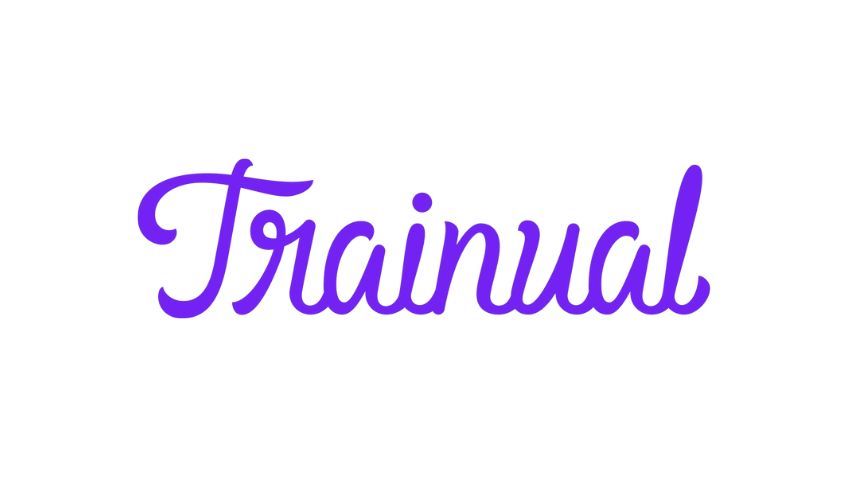
Trainual is a phenomenal way to bring new hires up to speed in any workplace where they have to start learning on day one.
It could be sales, it could be sushi, but many really intelligent people are not going to know enough walking in the door to start calling customers or putting food on their plate. Unlike other similarly powerful training tools, Trainual lets you start small with affordable prices and low user minimums.
Trainual markets themselves as a way to create a “playbook” for your company–something people can pick up and start using right away. They’re aimed at small businesses, but there are enterprise organizations using Trainual as well.
Personally, we think Trainual is the perfect way for small businesses to deliver training with all the polish of corporate training software and none of the clunkiness.
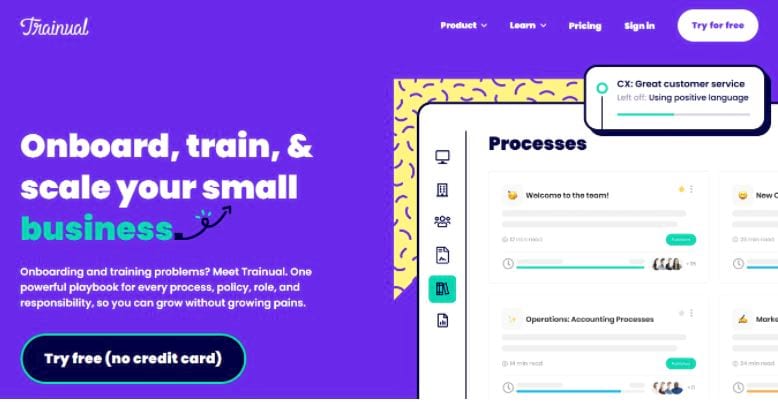
Where Trainual Excels
Say goodbye to the 200-page handbooks nobody reads (or maybe no one even wrote yet). Trainual lets you make training fun for employees and flexible for managers with an onboarding software option that’s well within the SMB price range.
Here are some of the highlights:
- SOPs become engaging training: we heard about exceptional templates, a modern design interface, and tons of page elements to choose from.
- Great visibility for admins: tracking employee training was simple, even down to the specific employee or course.
- Great mobile app: users told us that employees took trainings on their phone, happily, whereas other platforms got much less glowing reviews about their mobile app
We really recommend this to companies that need to create engaging training as part of their immediate onboarding. If you want to create full-blown learning paths and courses that dig into granular subjects, Lessonly by Seismic might work better for you as it’s more in the mold of a traditional learning management system.
Trainual comes at training from another angle. Instead of thinking about building a library of courses, it lets you turn your processes and policies into a playbook that employees can learn themselves.
Basically, you can turn any company’s SOP into training. You can break down your drab (but important) policies into digestible lessons. One user talked about the “fun” and flexible formatting for creating lessons. She liked being able to “pull in memes and GIFs and all that stuff” into her lessons to keep it engaging.
The owner of a restaurant chain noted that “we’re fast-casual shops,” and a lot of her workers are high school kids or college students. She felt like it was easier for her to convey information to them via Trainual’s engaging lessons.
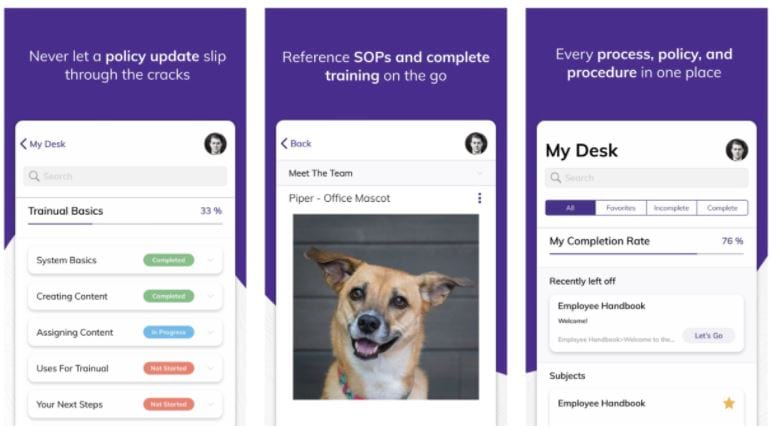
While Lessonly by Seismic also lets you create engaging course material, our research and interviews with users suggest that Trainual is a little easier to “make your own.” Lessonly by Seismic is much more templated, and you don’t have as much control over fonts, colors, or playful page elements like GIFs.
It’s not expensive and users we talked with were able to cut the time it took for employees to start contributing. Designing courses that fit your workplace and speak to your culture is a walk in the park.
“Trainual was cake,” said one user. “I was like, wait a minute. Is that it? It was so easy, and not to say that this is a simple product, because there’s a lot of different ways you can really make this your own for the company.”
Its approach may be playful, but Trainual is certainly capable of handling training in high-risk industries. One user we spoke with explained how Trainual revolutionized their old safety manual for drivers of vehicles carrying hazardous chemicals.
“Prior to Trainual, this was all done as them signing pieces of paper and reading it online,” she said. “It was like 150 pages. I don’t even know how they got the drivers to read it.”
With Trainual, she was able to take that massive document and break it out into 10 sections, each of which ends with a short quiz “to make sure that there’s the retention of the information that they just read, and that they actually read it.”
This is a story we heard over and over again from Trainual users. It was the perfect tool for conveying critical information to new hires–and making sure they actually understand it.
In the last example, drivers had to sign off at the end of every section, “If they have an auditor or something come in, we can run a report that says all these people have accepted this policy.”
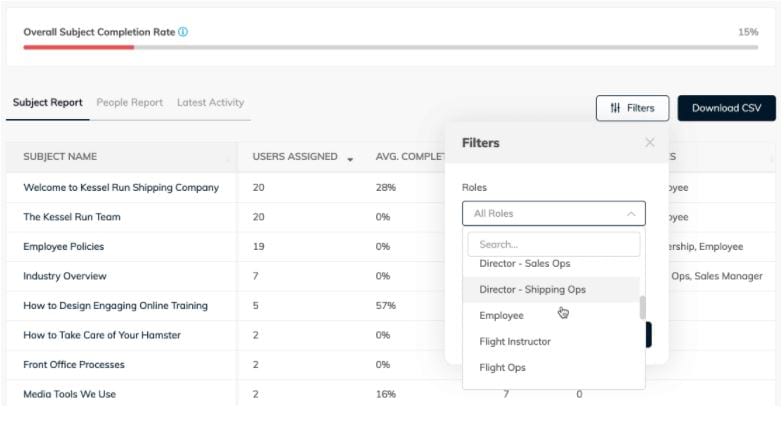
And Trainual isn’t just for entry-level hires. We spoke to one user who really valued her ability to train general managers.
“Anytime you’re dealing with managers in the field or in a restaurant or a shop, how they run things within their four walls is likely very different from manager to manager,” she said. With Trainual, she was able to train her new managers on a uniform process, and allow them to train their own employees in an order that made sense to them.
It was the perfect way to strike a balance between giving new managers the leeway they need to really “own” the kitchen they controlled. “The fact that [Trainual] allows us to really control the message that goes to every new hire is a huge deal,” she said, “because it just drives that consistency.”
Finally, Trainual’s customer service received incredibly high marks from the people we spoke with.
“It’s just amazing to me that I know these tech support people,” said one Trainual user. She knew them by name and felt confident reaching out with questions. “They’re so invested in making sure that we can do what we need to do.”
Where Trainual Can Improve
Trainual is a relatively new player in the onboarding space, and there are a few notable gaps compared to some of its more mature competitors:
- HR Integrations required: it’s easy to work the tax paperwork into your onboarding workflow, but Trainual doesn’t have built-in features to handle I-9s, W-4s, and so on.
- Surveys would be helpful: multiple Trainual users we talked to relied on outside tools for surveys and noted that the ability to get feedback within the platform was limited.
- Hard to track revisions to documentation: while you get great insight into employee progress, the lack of an edit history in Trainual Docs may pose challenges during an audit.
The first thing to be aware of is that Trainual doesn’t serve as a Human Resources information system–you’ll get org charts and directories with premium plans, but you will have to have another system to handle payroll, benefits, PTO, and so on.
Trainual does have integrations with popular HR software tools, but something like Gusto is going to handle all your tax docs and benefits administration directly in the platform.
One Trainual user we spoke to relied on her application tracking software to get new hires plugged into their system. “A lot of the ATSs out there have onboarding workflows,” she told us. “They just do a better job of the paperwork side of things.”
It’s good news if Trainual has integration with the ATS or HR software you’re using, but the bad news is that Trainual only includes these integrations with their most expensive plan. Being forced to upgrade to avoid a ton of manual data entry is going to be a bummer for smaller companies.
The lack of surveys in Trainual–something Lessonly includes–also bothered some of the users we spoke to. “You can definitely build in assessments to test knowledge,” said one user, “but it would be great to be able to build a survey into a course.” For her, it was important to get feedback on the training so that they could improve it over time.
“We’ve worked around that by just embedding a Google form survey,” she told us. “So that’s fine, but it would be nice to be able to build it in the tool itself.”
The final drawback we heard from users was that documents lacked an edit history. When it comes to company policies and processes, it’s really important to keep a record of changes, but Trainual is somewhat limited in this regard.
As one user explained, “You are able to go to see who has made a change, but you can’t see the specific thing that they changed.” This led her to create a separate audit log document where people have to note the changes they left. It’s an extra step bound to create confusion down the road.
Trainual Pricing
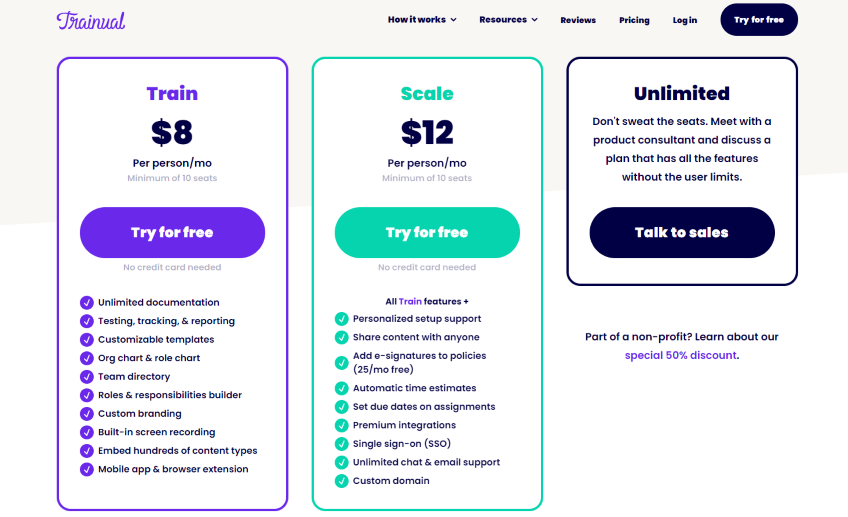
Anyone who has ever tried to purchase decent training software in the past will have their socks knocked right off by Trainual’s clear pricing terms. The affordability is equally surprising.
The Train plan is $8 per person per month with a minimum of 10 seats.
It works well for teams that never need to train too many people at the same time. You get unlimited documentation, an org chart and directory, as well as access to customizable templates and branding.
Upgrading to Scale gives you more tools to monitor employee progress. This includes personalized setup support, the ability to set due dates, and single sign-on (SSO) functionality.
The Scale plan starts at $12 per person per month and includes a 10 seat minimum.
If your onboarding is tied to compliance or certifications, we’d recommend the Scale plan or potentially Unlimited.
Unlimited has custom pricing, and comes with unlimited seats.
It has integrations with popular HR software and ATS to eliminate manual entry as employees move through your system. You’ll get additional royalty-free content to use in your courses, as well as additional channels to contact customer support.
As you can see, Trainual doesn’t really get more expensive as you grow. Yes, you have to upgrade, but you are never paying more than $12 a user per month on either the Train or Scale plan.
Bottom line: Trainual is a great tool for training new hires that fits within the small business budget and time scope.
Gusto – Best for Combining Simple Onboarding With Payroll
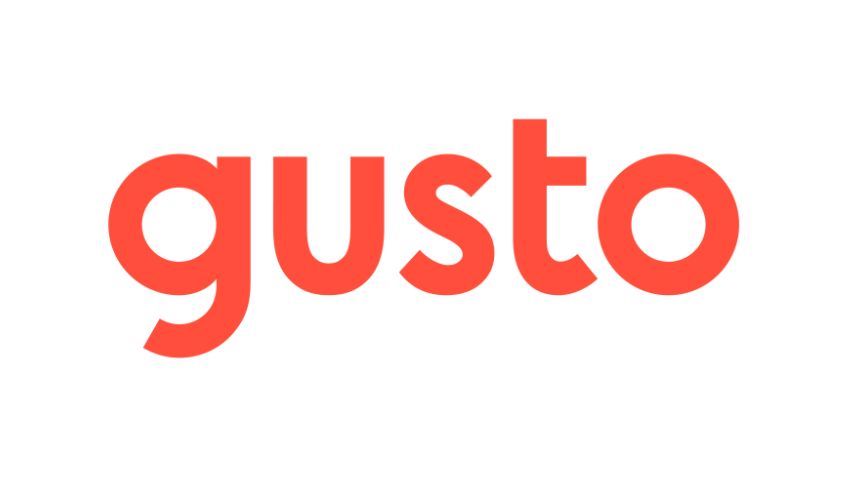
Gusto is an incredibly intuitive platform that’s built to help small businesses completely handle HR: onboarding, payroll, benefits, insurance, new equipment, everything.
You do not have to be experienced in HR to set up and run Gusto. Users we talked to said it made their lives a lot easier, and their employees loved the streamlined onboarding.
Unlike the two other standout HR all-in-ones on our list, Gusto does its own payroll–there’s no integration to set up. Employee payroll taxes are filed according to the latest federal, state, and local laws.
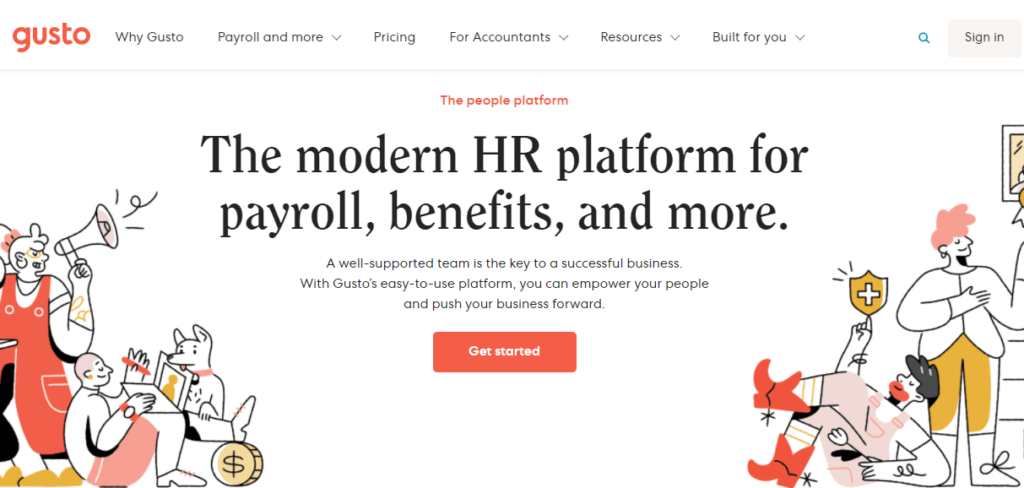
Where Gusto Excels
For the company that considers onboarding the process of getting a new employee plugged into the system and set up at their desk, nothing will get it done as fast as Gusto, or with as little drama. It offers:
- Error-proof interface: None of the typical new hire mistakes were happening once people switched to Gusto. Many successful administrators had zero previous HR experience.
- Compliance on auto-pilot: Create an onboarding checklist that ensures everyone knows what docs need to be signed and where they go next. Built-in eSignatures and easy document tracking make a complicated process as easy as possible.
- Affordable and transparent pricing: Gusto uses a clear pricing strategy that never surprised users, who were happy they could get such a good deal. This is a standout in the HR software field in that regard.
With Gusto, the user interface is so smooth and helpful, it feels like it’s impossible to make a mistake. Employees are responsible for entering all their tax documents and personal information. It’s all done digitally with eSignatures built right in, following onboarding checklists that nobody struggled with.
Gusto provides answers to tons of standard employee questions, which means those employees are not constantly sending emails to your HR team (if you have one). And you’ll never have to hassle people for documents during onboarding. Employees don’t have to print or mail any forms, ever.
“It’ll probably continue to save 50% of the time that we experienced before,” one user told us.
As the general manager and in charge of HR for a small seasonal lodge, they were able to completely automate the time-consuming task of onboarding and payroll. “It’s been great because we don’t have to think really hard,” he said.
Gusto made it easy to onboard, even if employees are in multiple states. “We knew we had some adjustments to make in terms of what state registration and taxes we need to deal with,” the user explained upon hiring someone in a new state. He simply identified the new hire’s tax home, and Gusto handled the rest.
It only takes a few seconds for admins to see exactly what paperwork is outstanding. With two clicks you can send them an alert. It’s far better than searching a spreadsheet, digging through your inbox, or trying to craft a pointed yet polite reminder.
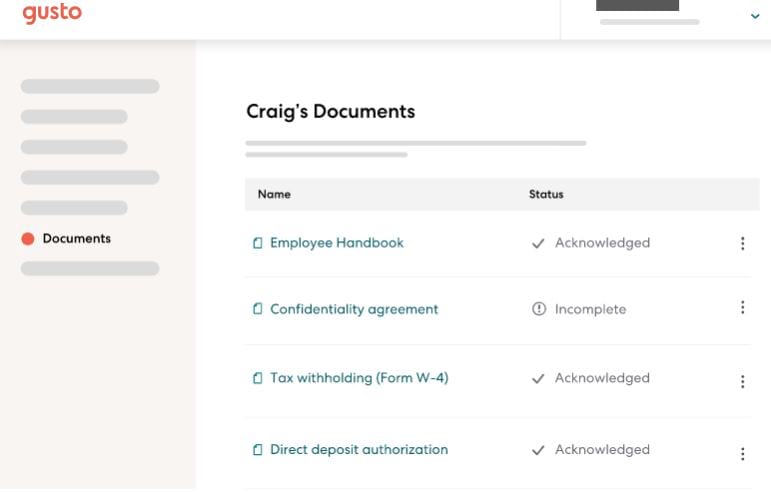
Another user who ran HR at a startup echoed the idea that Gusto makes it easy to streamline all the hard parts of onboarding, especially connecting new hires to payroll.
“I’ve never had to deal with a single W-2 issue,” he said and identified several other areas of compliance where Gusto sped things up, like setting up state unemployment and federal unemployment. “It automatically remits the money to those parties, withholds it from our setup, and remits it to the government. It files new-hire reports to the state. It does a lot of stuff automatically.”
Other options will connect to payroll through integration, but it’s not always smooth sailing. Gusto handles the whole process in-house, and your company looks sleek when the first check arrives–on time, no mistakes.
People stay in the system after they’re hired, using the welcoming employee portal. They’ll be able to understand and manage PTO, get answers to most of their tax questions, or update personal information on their own.
They’ll be able to manage their own benefits, too, if you offer health, dental, vision, 401(k), HSAs, FSAs, or any of the other plans Gusto offers.
We spoke to the owner of a nonprofit who really appreciated the ease of administration even for nonprofits, which can offer new employees both 403(b) and 401(k) retirement withholding. “Gusto has the robust concept of all those,” he said, “and I think that just gives us a really clear path.”
Think of Gusto as a product that works off the shelf. Sure, you’re not going to be able to create super complex workflows in Gusto like you can in GoCo, but it’s not going to take the same level of effort to get set up. Gusto just works, with minimal investment on your part. For simple onboarding, it’s more than enough, and it comes at a great price.
In fact, many users we spoke to told us that the cost of Gusto put it clear above other onboarding software they considered. It’s affordable, starting at a monthly cost of $6 per user on top of a $39 base fee.
“It’s cost-effective because we’re not bound to a large package for the features we need,” one user said. There was no mystery about what the cost was or what it would be. “They’re really upfront,” he said. “It’s just been a really open dialogue when we do have specific questions, and really easy to find information before we get to that point.”
Not everyone has thousands of dollars a month to spend for a system to get people onboard and paid. Not everyone has budget to pay someone to manage that system. Gusto is a complete package for most small businesses that will streamline that new hires first check.
Where Gusto Can Improve
Gusto works well out of the box for many companies, but there are a few things to be aware of:
- Can’t purchase HR services à la carte: Gusto has affordable plans, but you can’t pick and choose which services you get, so you may be stuck paying for things you don’t need.
- No mobile app: Gusto has optimized their site for mobile, but they don’t offer a true mobile app you could use for onboarding and administration. Gusto Wallet is useful for employees, but not an admin-side app.
- Limited post-hire training: you’ll have to use integrations to work courses and quizzes into your onboarding.
Gusto offers different tiers of services, and you need to upgrade all of your users in order to access certain features. We’ll go more in-depth in the pricing section about what each package includes, but there’s no way to mix and match.
With regards to onboarding, this gets annoying when things like the employee handbook builder and job description templates only come with the top-tier plan.
GoCo, on the other hand, lets you choose exactly which services you need. It’s also a lot more customizable, letting you build your onboarding workflows from the ground up. Gusto has really useful checklists, but they’re probably insufficient for a large organization with complex approval structures.
As one Gusto user noted, Gusto works really well when “onboarding just means adding someone to payroll.”
There were also a few users we talked to who encountered issues with Gusto’s specialized pay cycles. A user who managed HR for a nonprofit had some trouble with the first pay with salary and hourly workers. “It was a fairly simple fix,” she said, “but it was a little bit of a hoop-jumping headache to do in our first setup.”
Compared to other software used for onboarding, Gusto doesn’t include very much in the way of training tools. There isn’t a way to build courses or turn an employee handbook into something more engaging. This is a significant missing piece compared to the tools on this list that include detailed training options.
One final thing that bothered some users is the lack of a mobile app. Gusto Wallet is a handy app that lets employees manage their finances, but there’s nothing more than the web portal for administration. BamhooHR, another Gusto alternative for onboarding and HR, has a mobile app that employees and admins both seem to like.
Gusto Pricing
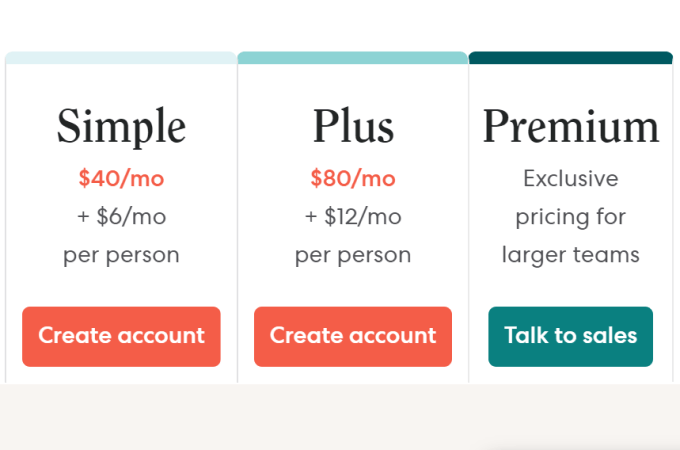
Gusto offers two pre-packaged plans for small businesses, as well as custom solutions for companies that are growing out of that category.
The least expensive plan, Simple, serves as a basic HR administration center for payroll and benefits. You get the excellent employee self-service portal, but importantly, you get some of the great onboarding tools we’ve described in the review.
However, if you are looking at Gusto for advanced hiring and onboarding, you need to go with the Plus plan, which has the customizable offer letter templates, customizable checklists, and the applicant tracking system.
The Plus plan supports payroll in multiple states, whereas the Simple plan only lets you run payroll in a single state.
Plus starts at a monthly cost of $12 per user with a $80 base price. Note that along with the great onboarding tools, Plus will help you manage PTO, time and attendance, performance reviews, and comes with some of the key culture-building tools like a directory, org charts, anonymous surveys, and more.
We recommend the Premium plan to companies that need extra support with HR and compliance, as you’ll get increased customer support to help navigate tricky questions.
Premium pricing is customized for your company. It gives you access to Gusto’s HR resource center, which has templates for job descriptions, performance evaluations, labor law policies, and an employee handbook builder.
All of these time-savers can help you create a sleek, professional onboarding experience.
Gusto’s transparent pricing stands in clear contrast to BambooHR and GoCo. We heard that both of those platforms are fairly well priced from users, but you’ll have to call them to find out. With Gusto, all the pricing info is right there for you to see.
Bottom line: For companies with simple onboarding needs, nothing gets new hires into your system faster and easier than Gusto.
BambooHR – Best Single Platform for Recruiting and Onboarding
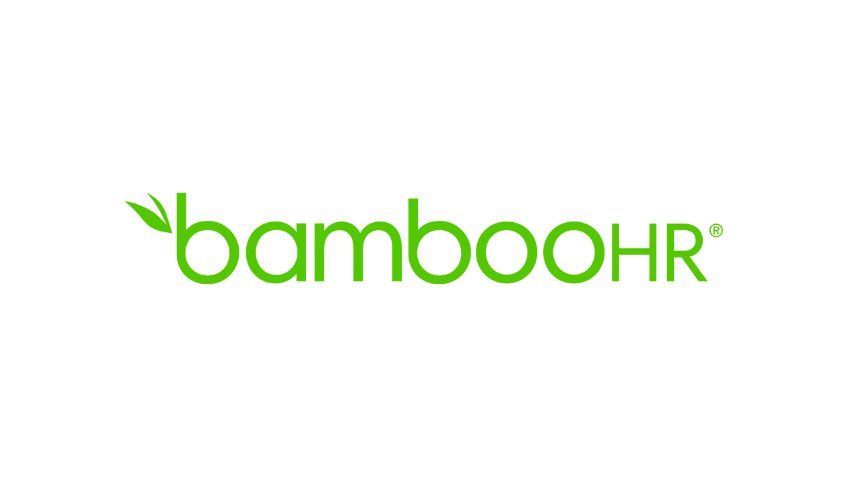
BambooHR is the only onboarding software we looked at that lets you handle the entire hiring process–handle job postings, screenings, interviews, signing, and employee administration within the same platform.
Instead of patching together a bunch of different tools to handle each part of the hiring process, use BambooHR and make things easier on everyone.
It’s a full HR platform, but unlike Gusto or GoCo, BambooHR has a built-in applicant tracking software for finding and closing good hires. It’s a little more mature than the other two platforms, with a more robust employee self-service portal and a much longer list of integrations and add-ons to further extend the platform’s capability.
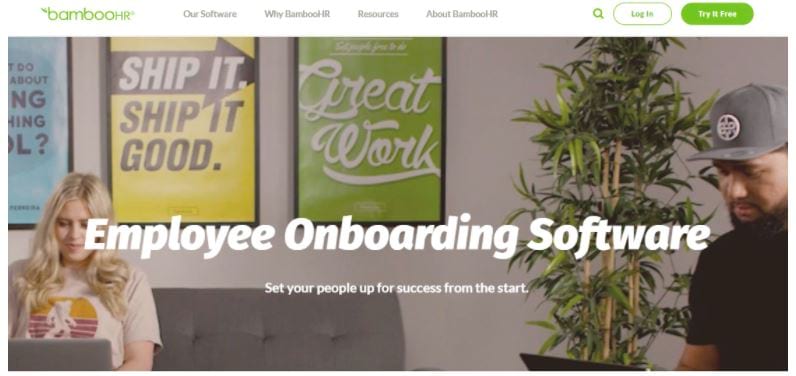
Where BambooHR Excels
When people sign into BambooHR for the first time, they tend to see right away why it is growing in popularity with a broad range of companies.
- Very user-friendly: both employees and admins have no trouble answering their own questions when it comes to navigating the BambooHR interface.
- All-in-one HR platform: admins loved handling everything within the same interface throughout the employee life cycle.
- Plays well with other software: BambooHR has partnered with a long list of companies to ensure that your tools integrate with as little fuss as possible.
BambooHR requires very little training for HR teams to use. Employees start feeling confident about managing their affairs right away.
We’ve spoken to Bamboo users at companies with thousands of employees and companies with less than 50–they all rave about how intuitive it is. The mobile app is quite good, allowing both employees and admins the ability to accomplish most of what they can do in the desktop interface no matter where they are.
We’ve gone in-depth on other aspects of the full BambooHR platform in my best HR software post, so here we’re going to focus on the onboarding aspects of the full platform.
For most users, BambooHR is about efficiency, handling as much as possible within a single platform. “We send all the documentation, the contracts and offer letters, everything through BambooHR,” said one user. They appreciated the ability to customize workflows and add triggers so that every single step could be part of a uniform, automated process.
“The IT department knew when someone knew what was coming and everything that they had to prepare,” she added. “It was very easy for us to communicate and very automated.”
It’s easy for admins to keep track of where new hires are in the process, getting them permissions, equipment, and information on time. Your teams can coordinate everything on the same platform.
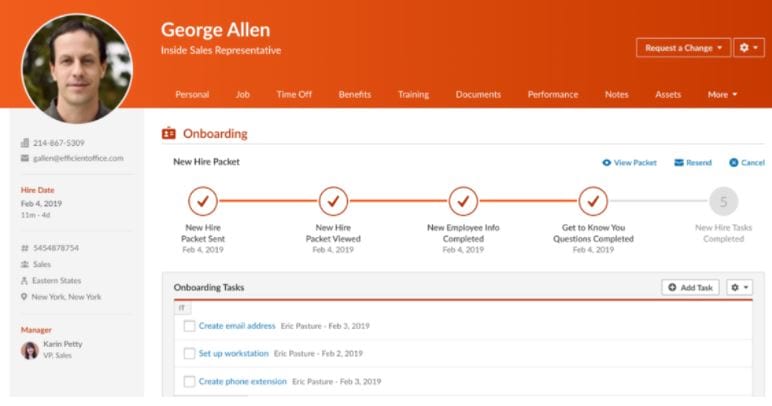
Another HR manager at a small tech firm echoed these sentiments and told us how BambooHR “definitely sped up” their onboarding process. She said they saved 5-8 hours per hire once they had it set up, and more once they started increasing their recruiting. Plus, it made their company come off a lot more professionally.
“Giving [new hires] a binder with 200 pages to look at doesn’t really say, ‘We’re a high tech company!’” she explained. “I think that having the BambooHR system, I think that our new employees are definitely impressed.”
As one user described, everything her teams needed was built into BambooHR–recruiting, hiring, onboarding in one platform. “The managers really like that process, because we can rate the employees, we can bounce ideas back,” she said. “We just roll everybody up whenever we hire into the system for onboarding.”
BambooHR even includes payroll, though as an add-on option rather than fully included like Gusto. BambooHR uses TRAX for payroll, which has gotten far better reviews from users we’ve talked to than their previous embedded solution, Execupay. A lot of payroll issues have disappeared since this switch–and notably, GoCo uses Execupay as their embedded payroll, which has gotten them some bad reviews.
No one has to sign in to multiple accounts to get anything done in BambooHR, either. This is helpful for admins who don’t have to juggle tools and is effortless for new hires, as the employees stay in the same system from the moment they apply for the job until they retire.
“I’m attracting and recruiting and doing applicant tracking through Bamboo,” said one user. “I’m hiring through there, and then they have a virtual welcome package set up where I can show them their team that they’re joining, link them to our directory, give them our handbook, get their e-signature for that. All the compliance pieces.”
If you are looking for a single onboarding tool for end-to-end recruitment and onboarding, BambooHR is it. Gusto can’t handle applicant tracking in-house (you’ll have to rely on integrations) and GoCo is going to take a lot more setup than BambooHR to get the same result.
And neither one of those options has a mobile app that competes with Bamboo’s. Gusto doesn’t have one at all, and GoCo’s mobile experience has a long way to go.
BambooHR users felt confident about handling virtually anything from their phones. Employees were fine to manage their affairs, and admins could recruit, onboard, and manage many other day-to-day tasks.
There’s just so much built into BambooHR. The pricing structure allows you to bundle the standard services and add on what you need from there. The BambooHR app marketplace offers a deeper selection of high-quality integration with more tools than any other platform we looked at.
Companies with a slew of different tools can use BambooHR to consolidate them. It doesn’t matter where you are coming from.
“We’ve bought several companies that are subsidiaries of ours now,” one user told us. “And every time that we onboard a new company, we put them on Bamboo and these are companies that are anywhere from 10 employees to 30 and they all actually end up keeping it.”
We can’t think of a better endorsement for the HR team looking to move operations to a single platform.
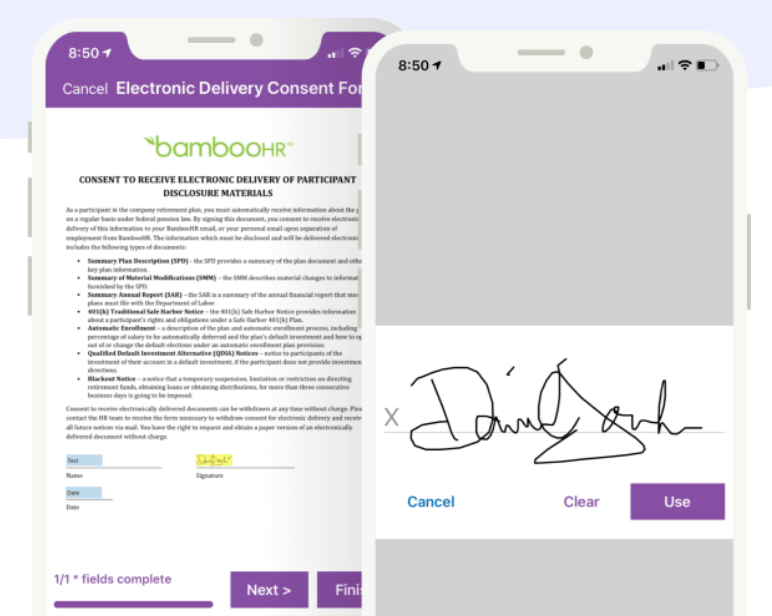
Where BambooHR Can Improve
As good as BambooHR is, there are some onboarding use-cases where it might not work as well as some of my other recommendations. A few tradeoffs to consider:
- Limited training tools: you can create robust new hire welcome packets and deliver plenty of info–but if you want to build out substantial training, you’ll need to integrate with a tool built for that.
- Built-in reporting is limited: the canned reports were helpful, but users who wanted to customize had to get help from BambooHR.
- No posted pricing: you will need BambooHRs more expensive plan for onboarding, but you’ll have to call for a custom quote.
BambooHR advertises a good deal of training features on their site, but the users we’ve talked to found them fairly thin. One user we spoke with used BambooHR for the new hire paperwork and then transitioned people into Lessonly for training.
It would have been nice to keep everything under one roof, but this user had employees working with hazardous chemicals. BambooHR simply didn’t have the built-in training to support new hires or the robust reporting to hold them accountable.
With Lessonly by Seismic or Trainual, course builders and clear methods to track employee progress are built-in and simple to use.
Another user ran into problems trying to customize reports in BambooHR, which is something we’ve heard before. It simply wasn’t possible for her to capture the information she needed without getting support from BambooHR. And even then, there were still problems.
“Support was very good and they helped us create customized fields to add that information we need,” one user told us. “However, if we wanted to generate a report based on that field we couldn’t because it was a customized field, we couldn’t generate a report.”
This isn’t going to bother every user, but people looking for really in-depth reporting should consider GoCo. Their Magic Docs feature makes it easy to capture and report on anything you need.
Another thing to keep in mind is that BambooHR doesn’t post its pricing publicly. We’ll go into more depth on the different packages BambooHR offers in the next section, but some users found the lack of transparency a little frustrating.
As one user said, “We really had hoped that we could use one system for our time management and our HR, but we just weren’t able to work it out [with Bamboo] because of the price.”
BambooHR Pricing
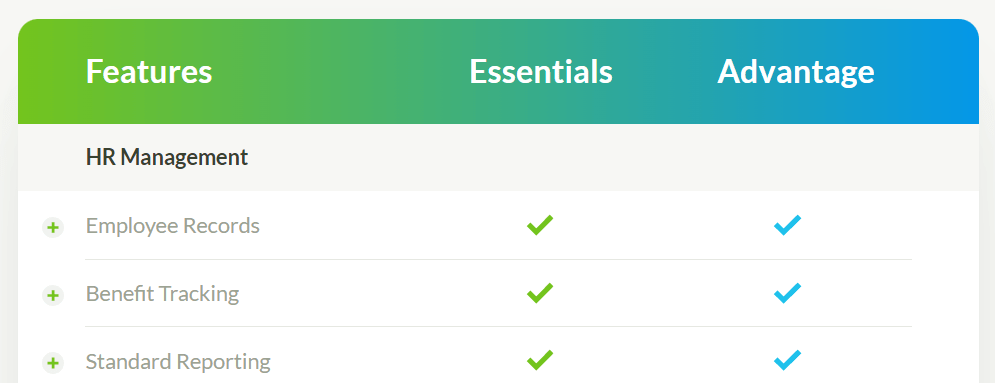
BambooHR offers two packages for their software: Essentials and Advantage.
Essentials is an HR administration platform with employee self-service. It does not come with the hiring and onboarding tools that we’ve described in this review. Those come with the Advantage plan and include:
- Applicant tracking system (ATS)
- Audit trail
- Custom workflows and approvals
- Role-based access control
- eSignatures
- Onboarding
- Offboarding
- Training tracking
The built-in ATS allows you to recruit, sign, and onboard a new employee within the same system. This saves time and avoids the hassles of integrating your ATS or HR system with onboarding software. eSignatures are built into the platform, so everything is handled in one screen.
Payroll, time tracking, and performance management are add-on services. Gusto has these built-in, though the performance management features are a little lighter than what you can do in BambooHR.
Not everyone wants to switch up their payroll or time tracking just to speed up onboarding. BambooHR doesn’t let you pick and choose your exact suite of services like GoCo, but it is a little more flexible than Gusto’s all-in packages.
So you don’t get to see the price ahead of time with BambooHR, but in the end, you’ll probably wind up paying for fewer features you’re not using than you would with other products on this list.
Bottom line: BambooHR helps companies recruit, hire, and onboard better with fewer tools than they were using before.
The Review Process
What It Took To Be Included
The goal of onboarding software is to make the transition easier for new hires and get them performing in their role as quickly as possible.
To this end, good onboarding software will help a company with:
- New hire paperwork: creating workflows to make sure employee documents get signed and filed automatically.
- Compliance: allowing employees to make required acknowledgments, set up deductions, and attend mandatory training.
- Enculturation: helping employees get to know their role, responsibilities, organization, and people they work with.
- Training: providing employees with courses and assessments to build their skills and test retention.
When we looked at the market for onboarding software, we found that the word onboarding means very different things depending on where you work.
We wanted to select a range of onboarding software that would meet a variety of needs, but there were a few things we knew that we wanted to see no matter what:
- Simple for new hires: These products should help your company make a strong first impression–your company has got its act together and there’s zero confusion about what to do next.
- Great visibility for admins: It should be easy to keep track of what step an employee is completing in the onboarding process, or to keep tabs on their progress through training.
- Integrations with popular software: Onboarding software doesn’t exist in a vacuum, it needs to plug in with your other software to keep the employee experience seamless and reporting accurate.
- Rapid deployment: It should take hours or days to get your onboarding solution operational, not months.
Who We Interviewed
Once we had a list of onboarding software that we felt captured the best options, we moved into the next phase of research: Talking to actual users about what these products are like to use to onboard real people.
Over the course of a month, we coordinated interviews with active users of each product, confirming identities via LinkedIn. A lot of the products we looked at do a lot more than just onboarding, but we focused interviews on what it was like to bring new hires on.
What We Learned Choosing the Best Onboarding Software
Our team spoke with a lot of happy users, but some of them had been using software for onboarding in the past that wasn’t getting it done.
Now that they had something that truly fit with the needs of their workforce, bringing on new employees was predictable and stress-free.
What we learned from our research can help you find the missing piece to your onboarding puzzle.
Nobody Regrets Automating New Hire Paperwork
We talked with people who switched from paper documents to digital workflows. We also heard from those who switched from clunky onboarding software to more streamlined options.
Everyone was saving so much time by using the right products. Some of the key features that were making a difference:
- Employee self-service: were HR managers responsible for collecting paperwork, or was it all handled in the platform by employees? Could they access/update their personal details later?
- Checklists and workflows: was it easy to create and edit onboarding checklists? Could you customize the steps in the onboarding process? How easy was it to automate these steps?
- HR Integration: did products have built-in abilities to handle payroll, benefits, administration? Were there integrations for HR responsibilities that can’t be handled in the platform?
You’ll find that basically all of my recommendations let you organize and automate your onboarding processes. New hires know what needs to get done, and it takes less time for admins to ensure that everything is where it needs to be.
As one Trainual user told us, “I’ve worked in HR for more than 10 years now, and the automation that comes along with onboarding if you can get there, is a huge time saver.”
It will take you time to set up a learning path or onboarding workflow, but once it’s in place, everything happens on its own with few, if any, mistakes. As she said, “Once I get someone set up in [Trainual], I mean they can pretty much rock and roll on their own without any involvement from me.”
Onboarding software also makes your processes consistent. One GoCo user talked about how his HR staff benefited from having a transparent, objective process across the company.
He stressed the importance of the uniformity of “people seeing the exact same thing, people being comfortable with what they’re doing versus there being a different process, depending on which HR manager is handling the onboarding.”
When you are thinking about what is going to automate your processes best, we’d recommend Gusto for people with a fairly standard workflow. It’s great for small businesses that just need to check all the boxes and make sure the checks go out on time.
GoCo is going to let you build and automate a lot more, but it needs more setup on your end. If you can get by with a simple checklist, Gusto and BambooHR are probably enough to give you an onboarding experience that largely runs on autopilot.
Trainual and Lessonly by Seismic are incredible for automating training processes–but you are going to need HR software like the other three options in order to automate an employee’s transition to payroll, benefits, and so on.
HR integrations will be important if you go this route, especially if you are hiring a lot of people. Both Trainual and Lessonly by Seismic have pre-built integrations with popular HR software that will allow you to automate your processes and avoid manual entry.
Start Employees Off On the Right Foot
Walking into a new office or signing onto the first zoom call is a pretty wild experience. Anything you can do to minimize anxiety and uncertainty for new hires is a good thing.
Good onboarding software, as we discovered in our research and interviews, helps new employees in concrete areas, such as:
- Understanding new relationships: were there org charts, directories, in-app messaging, pictures in employee files? Did new hires know where to go when they needed help?
- Setting workplace norms: was it easy to create employee handbooks, job description templates, updated company policies? Could users edit and format documents and lessons to align with their company culture?
- Joining the culture: were users able to help employees feel like they belonged? Was successful onboarding having a positive impact on retention?
We were surprised to hear about the impact fairly sterile things like org charts and directories had on new hires. We think it’s one of those things that more people use now, simply because platforms like BambooHR and Gusto are so incredibly user-friendly.
“You can just go into the Bamboo app, search people by title or name or even picture,” one HR director at a 65 person business told us. This really helped new hires get acquainted with the people they’re going to be working with.
Employees can also send messages directly in the Bamboo app. “That helps newer people,” she said, “if they don’t quite know who to go to, but they know they have an issue.”
GoCo and Trainual allow you to make your org charts more interactive. With GoCo, you can search it on a dashboard and show relationships in different departments.

Being able to filter your org chart is important to large companies and fast-growth companies, which GoCo is built to serve. Small companies can probably get by without interactive org charts.
One Trainual user really appreciated how titles and job descriptions were required fields that showed up in the org chart. This was “great for their employees” she said, “Because I think it’s really important that people look someone up and they know what they do.”
Lots of the tools we looked at will help you build employee handbooks, but Trainual and Lessonly by Seismic clearly stand apart in terms of what they can do in terms of delivering important information to new hires.
A different Trainual user told us about her experience scaling to eight poké restaurants. She’s hiring a lot and planning to grow further.
“We’ve taken our employee handbook and made it into a Trainual course for onboarding,” she said. To her, conveying the basics of workplace safety and hygiene had to happen alongside an introduction to their culture. Because she was creating her own courses in Trainual instead of sending people a 100-page PDF handbook, she found it much easier to get new people on board. It’s “very upfront,” she said, but “you can make it pretty fun.”
Lessonly, too, can help you put your own spin on courses to introduce new hires to your culture–more on that in the next section.
Once They Have The Job, They Need To Know How To Do The Job
Onboarding software comes with a range of tools for training. Depending on what you pick, you’ll be able to handle
- Day-one stuff: can you get employees everything they need to know to start working?
- Role-specific training: can you build out training materials that teach new hires the skills they need in sales, behind the wheel, or in a kitchen? Could training be tied to compliance responsibilities?
- Clear path for advancement: do employees have a clear sense of the steps they can take to move up in the company?
BambooHR and Gusto are incredible for the day-one stuff, making it easy to create new hire packets and ensure that people have what they need to start working.
But both of these options are a little thin in terms of built-in training tools. There are integrations, but they are going to work best if most of the training happens in-person rather than on the onboarding platform.
Since GoCo is a lot more customizable in terms of the workflows you can build, we weren’t surprised to hear from users that had more substantial training processes built into their onboarding process.
As one user explained in our review of GoCo, their fleet management company saw a 30% decrease in accidents by instituting some basic driver training as part of onboarding.
Still, GoCo doesn’t give you an easy way to build your own training courses, like Lessonly by Seismic and Trainual. These are our clear recommendations for companies that need new hires to gain some basic knowledge and skills in order to start contributing.
Trainual is the better option for smaller businesses price-wise, and you’ll be able to whip up engaging courses that make people ready for the kitchen or a sales call.
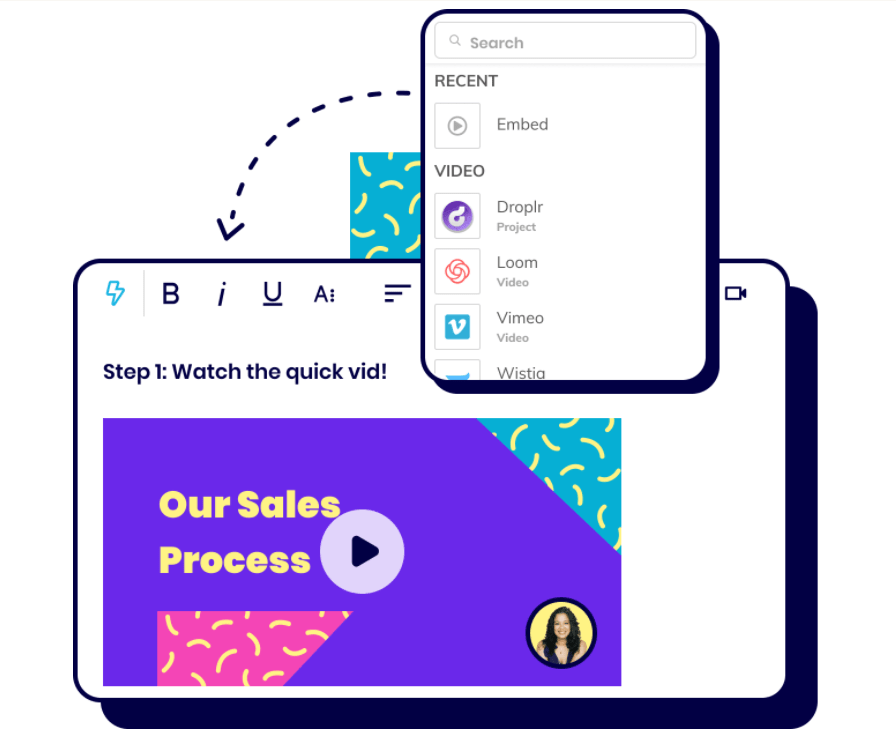
Trainual calls it creating a “playbook” for each role, and I think that’s a good way to think about it. You can quickly build out on-brand training to get people up to speed.
Lessonly by Seismic is really more for people who want to build out concrete courses, especially if they are tied to compliance. Think more of lesson libraries than playbooks.
We’d really recommend it for people with onboarding that lasts 1-3 months or longer, and those in regulated industries where onboarding is tied to compliance.
One very satisfied Lessonly by Seismic user we spoke to, for example, took their old 150-page safety manual for drivers of hazardous chemicals into 10 sections that drivers have to go through. They get quizzed afterward to make sure they read it.
You can really build out a clear path for advancement with Lessonly by Seismic, which can be important on day one. As another user told us, they’ve been able to train technicians quicker and keep them around longer.
“Just laying out the expectations and any limitations on the front end has maybe increased confidence and satisfaction of how people move up and get paid more.”
What Gets Tracked Gets Done (And Done Better)
With a digital onboarding process, every step is tracked, recorded, and time-stamped without any extra work. You want onboarding software that makes it easy to:
- Monitor progress: could admins see exactly where each employee was in the process? Could admins track employee progress through training and test retention?
- Support audits: were there audit trails in documentation and a clear record of everything the employee received, read, acknowledged, and signed? Were users (and their lawyers & insurers) satisfied by their ability to know what happened when?
- Conduct surveys: could users survey employees in the platform, or was it an outside integration? Were users able to learn about their process and iterate productively?
Keeping track of progress during onboarding is so important. We really liked how easy Gusto made it to create an onboarding checklist, which made it easy for both admins and new hires to see exactly what was supposed to happen next.

The reporting in Gusto is fairly thin, though. There are some handy pre-built reports, but these are focused more on payroll than on onboarding per se.
BambooHR got slightly better reviews in terms of reporting, tracking progress, and really understanding how to improve their process. One user was delighted to finally have metrics for tracking employee demographics, turnover, retention, and attrition rates. “It helped us a lot to get to know our people, and design strategies to retain them.”
Gusto and BambooHR both have built-in options for surveys, and GoCo has a host of options for including surveys at any step of the workflow.
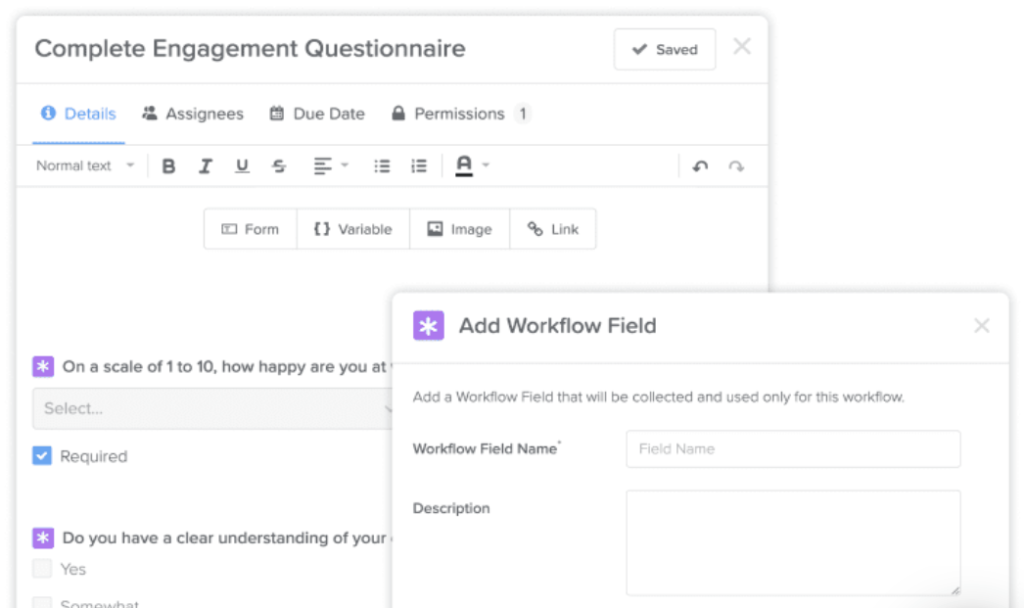
In order to constantly improve processes, these tools can be really important. There is no built-in survey tool for Trainual, which users really didn’t appreciate. Lessonly by Seismic does have surveys.
In terms of keeping people on track during onboarding, any of the tools we have recommended will work. If you have substantial training as part of your onboarding process, we’d highly recommend taking a look at Lessonly by Seismic and Trainual.
Along with deeper course creation tools, you’re going to get the ability to actually track employee progress.
As one user explained, as long as they tag a certain policy as required training, Trainual will automatically report completion to administrators. She said it was “really helpful” because (gasp) employees sometimes lie and leave training for the last minute. They say they’re “working on it,” she says, “and I look at it and it’s like 7% done.”

It’s critical to be able to intervene, especially where training is a safety concern. As one Lessonly by Seismic user noted, real-time visibility into training progress is key for safe scheduling. “We might require that until you take this lesson and pass the quiz, you can’t be assigned to a job where they’re working with that chemical.”
Without the right knowledge, her employees could really hurt themselves. She needs to be 100 percent certain that people have read and understood the training. Lessonly by Seismic makes this process easier to enact across her company, and simple to track moving forward.
Conclusion
Onboarding does not have to be stressful with today’s solutions. We’ve recommended five different products that will help companies put their best foot forward with new hires.
As you know by now, these products are very different from one another, even if they all help with onboarding. Use our reviews to figure out which one has what you need, and follow the links to learn more.
What are you using to onboard new hires?

